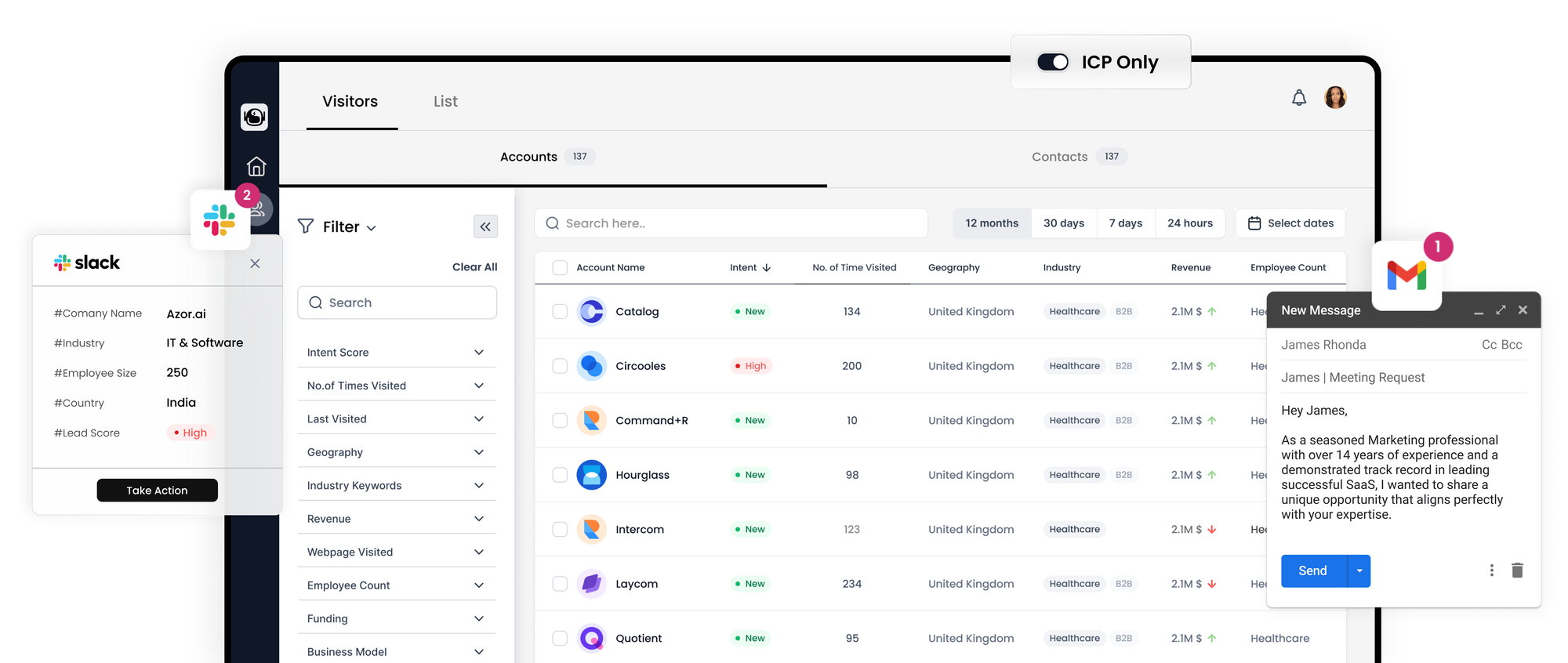A Comprehensive Guide to Account-Based Marketing in 2023

Account-Based Marketing (ABM) continues to play a pivotal role in 2023, facilitating personalized marketing communications that meet the expectations of today's customers. In essence, ABM leverages the collective expertise of both sales and marketing teams to concentrate efforts on a specific group of accounts, aiming to create a tailored and highly relevant marketing experience.
As of today, an impressive 67 percent of brands actively employ account-based marketing during their account research phase. Additionally, when it comes to ABM tactics, 'identifying target contacts' ranks as one of the top two methods preferred by marketers, as revealed in 'The State of Marketing Trends Report 2022.'
The adoption of this account-based selling model brings forth numerous advantages for businesses. It yields a high return on investment (ROI), enhances personalization, and facilitates efficient tracking of marketing efforts. However, before delving into these benefits, let's start by understanding what ABM truly entails.

What Exactly is Account-Based Marketing?
Account-Based Marketing, often referred to as ABM, represents a more focused approach to sales. It revolves around identifying best-fit accounts, those that have expressed interest, or potential high-revenue prospects. An effective ABM strategy strikes a balance by incorporating both prospects and complementing a lead-based approach.
The core principle of account-based marketing centers on precision: targeting the right individuals with the right message at precisely the right moment through account-specific campaigns. This approach necessitates highly personalized and relevant messaging and content tailored to each contact's unique needs and preferences.
According to Dave Chaffey, ABM can be categorized into three distinct types: strategic ABM, ABM Lite, and programmatic ABM. The level of investment and expected ROI varies based on the degree of personalization and automation involved.
In the strategic ABM approach, consider a scenario where an HR Manager at a target company downloads an ebook titled 'How to Manage a Remote Team.' Leveraging ABM, a salesperson can subsequently reach out to this individual, offering relevant blog content or a complimentary consultation on training.
The choice of targets in your ABM strategy hinges on your specific business objectives. For instance, if your company is venturing into a new vertical, such as healthcare, you would compile a list of target companies and individuals within that sector who might express interest in your offerings. This targeted approach maximizes the likelihood of success in your ABM endeavors.
Understanding the Advantages of Account-Based Marketing (ABM)
Account-Based Marketing (ABM) offers a multitude of benefits for businesses, making it a compelling strategy to adopt. Here, we explore some of the key advantages:
1. Delivers High ROI
ABM, when executed effectively, has the potential to yield precise and impressive results for any business. Recent research indicates that a remarkable 76% of marketers reported achieving a higher Return on Investment (ROI) with account-based marketing compared to other marketing strategies. The underlying reason behind this success lies in ABM's ability to generate and nurture high-quality leads. By treating these leads with personalized care and providing value throughout their journey, ABM boosts engagement and conversion rates.
2. Enhances Personalization and Optimization
A significant aspect of ABM is its emphasis on personalized messaging and tailored communications directed towards specific accounts. This targeted approach ensures that campaigns resonate deeply with the intended audience. When content is tailored to individual needs, preferences, and business contexts, it becomes considerably more engaging. By experimenting with various content types, businesses can discover what works best for their particular audience.
3. Accelerates Sales Cycles
In the realm of B2B sales, numerous stakeholders often play pivotal roles, especially in the later stages of the sales cycle. ABM offers a valuable advantage by establishing advocates within the target business. These advocates not only possess a relationship with your sales team but also receive personalized and relevant information that can be leveraged to close deals. Consequently, ABM facilitates the acceleration of the sales process, mitigating potential delays associated with traditional non-tailored approaches.
4. Builds and Nurtures Relationships
ABM enables businesses to cultivate relationships with prospects that can extend beyond the sale. This opens doors for creating deeper connections and fostering brand advocates who champion your company both internally and externally. Word-of-mouth endorsements are incredibly influential in the world of sales, making close and meaningful relationships nurtured through ABM a valuable asset. Moreover, these relationships provide insights into future customer needs and contribute to improved retention rates.
5. Enables Sales and Marketing Alignment
One of the notable advantages of ABM is its ability to foster effective alignment between sales and marketing teams, a goal that can be challenging to achieve. Marketers who execute ABM programs find that their approach closely mirrors that of sales. Both teams focus on accounts, targeting strategies, lead generation, and revenue generation, creating synergy that enhances overall efficiency.
6. Allows Focused Resource Allocation
ABM's highly targeted nature enables marketers to allocate their resources with precision. This strategy optimizes promotional campaigns, directing internal talents, technologies, social platforms, analytics tools, and content creation resources toward specific, well-defined accounts. Such focused resource allocation is a key driver of positive outcomes in ABM campaigns.
7. Facilitates Easy Tracking and Measurement
ABM provides a level of clarity and accuracy in analytics that is well-suited for assessing campaign effectiveness. Analyzing the performance of an ABM campaign is more straightforward, as it involves a smaller set of targeted accounts rather than a sprawling range of metrics spanning an entire database. This streamlined approach enhances the ability to draw meaningful conclusions and make data-driven decisions.
Implementing a Successful Account-Based Marketing Strategy
Now that we've established the importance of account-based marketing (ABM) and its associated benefits, let's delve into the essential components that contribute to the effective implementation of an ABM strategy:
1. Identify Your Targets
The cornerstone of a successful ABM strategy is the precise identification of your target accounts. Random and unfocused efforts rarely yield positive results. Instead, focus on developing well-defined buyer personas. These personas serve as valuable templates to guide your targeting efforts. By leveraging available technology, prioritize high-value accounts based on factors such as revenue potential, market influence, and purchasing capacity.
2. Understand Your Targets
Once you've pinpointed your primary target accounts, dive deeper into understanding them. Conduct thorough research on each company to gather critical information such as their product offerings, annual revenue, and competitors. Simultaneously, explore the profiles of key decision-makers and influencers within these organizations. Familiarizing yourself with this core information allows you to segment your target accounts effectively, akin to how a persona-based marketing strategy caters to multiple stakeholders.
3. Define and Personalize Your Content
A successful ABM campaign hinges on the deployment of valuable content that addresses the key business challenges faced by your target accounts. Consider how your messaging and content can actively assist these accounts in overcoming their challenges. Personalization is key; your content should exude trustworthiness, provide informative insights, and establish your authority in the field.
4. Choose Relevant Channels
To ensure that your target accounts genuinely engage with your core messaging, leverage various communication channels. These channels may include social networks, mobile platforms, and other online mediums. Keep in mind that different industries and roles within those industries gravitate towards specific channels that align with their needs. Thus, it's imperative to tailor your outreach to the platforms that resonate most effectively with your target accounts.
5. Offer Solutions
Irrespective of industry or role, individuals invariably seek solutions to their immediate challenges. Understanding these challenges is pivotal. Once you've gained insights into the hurdles faced by your target accounts, create content that provides solutions. This can include whitepapers, blogs, and eBooks filled with valuable insights that drive engagement.
6. Measure and Adapt
Once your ABM strategy is operational, it's critical to measure all marketing activities pertaining to your target accounts. Determine which channels and content types yield the best results and adapt your campaign accordingly. This iterative process ensures that you allocate your resources effectively and maximize the impact of your strategies.
7. Automate Processes
Automation plays a pivotal role in streamlining tasks and enhancing efficiency for your team. Explore marketing automation technologies and tools that can expedite and optimize your processes. For instance, consider implementing a Customer Relationship Management (CRM) system to track communications and share essential information. Additionally, setting up email workflows can help nurture and track the engagement of key prospects within a tailored funnel, further enhancing the success of your ABM efforts.
